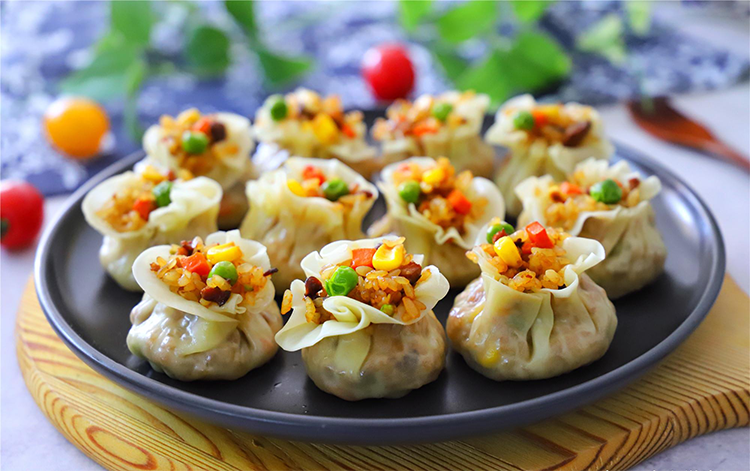Chrysanthemum Shaomai: Changsha’s Flower-Shaped Dim Sum
In China’s rich culinary map, every regional snack tells a story. Chrysanthemum Shaomai (菊花烧卖) from Changsha, Hunan, is both a delicious dim sum and an edible work of art. With its delicate, flower-like shape, translucent steamed wrapper, and juicy filling of pork, shrimp, and shiitake mushroom, this local specialty captures the essence of Hunan flavor. Whether you’re a food lover or a cultural traveler, tasting Chrysanthemum Shaomai is a must on any Changsha visit.
1. Origin and History: From Court Treat to Street Favorite
Chrysanthemum Shaomai traces its roots back to the Ming and Qing dynasties. Legend says it began as a refined snack in Hunan official households or imperial kitchens, prized for its elegant appearance and fine ingredients. Over time, local chefs in Changsha adapted and popularized the recipe, bringing it into teahouses and street stalls. The name combines “shaomai” (a steamed dumpling style) with “chrysanthemum,” describing the pleated, petal-like top that gives the dim sum its distinctive look.
2. Cultural Significance: A Bite of Huxiang (Hunan) Life
In Hunan, eating is about community and culture as much as flavor. Chrysanthemum Shaomai embodies the Huxiang emphasis on balance between aesthetics and taste. It often appears at morning tea, family gatherings, and festive tables—symbolizing reunion, craftsmanship, and local pride. For visitors, enjoying a steaming basket at a traditional teahouse offers a window into Changsha’s culinary history and everyday life.

3. Ingredients: Fresh, Balanced, and Layered
Authentic Chrysanthemum Shaomai relies on careful ingredient choices. The wrapper uses high-gluten flour rolled very thin so that, after steaming, it becomes slightly translucent and slightly elastic. The filling is the star: a mix of fresh pork (fat and lean), plump shrimp, fragrant shiitake mushrooms, and often bits of bamboo shoot or water chestnut for crunch. Typical seasonings include tea seed oil (a Hunan specialty), light soy sauce, minced ginger, and white pepper. Some traditional shops add crab roe or a small spoon of jellied chicken stock to create extra juiciness after steaming.
4. Making It: A Craft in Your Fingers
Shaping Chrysanthemum Shaomai is a skilled, patient process. Dough is kneaded and rolled into thin round wrappers. A spoonful of filling goes in the center, and the maker gathers the wrapper edges with the thumb and forefinger—without sealing the top—so the filling peeks out. The finishing touch is the pleating: delicate pinches around the rim create even “petals,” forming the chrysanthemum silhouette. Finished dumplings are placed in bamboo steamers and cooked over rolling water for about 8–10 minutes until the wrappers glow slightly translucent and the filling turns tender and juicy.

5. Flavor and Texture: A Multi-Layered Bite
Eating a hot Chrysanthemum Shaomai is a sensory experience. The first impression is the aroma of steamed dough and savory filling. A bite reveals a thin, slightly chewy wrapper followed by a burst of savory, juicy filling—pork’s richness, shrimp’s sweetness, shiitake’s umami, and the crisp contrast from water chestnut. Hunan seasonings give a balanced savory profile with a faint warming spice. The combined textures and layered flavors make it addictive.
6. How to Eat It: Local Pairings and Tips
In Changsha teahouses and snack shops, Chrysanthemum Shaomai is usually sold by the basket (a basket holds about four to five pieces). Eat them hot for the best flavor. Common accompaniments include aged black vinegar to lift the savory notes, and a drizzle of chili oil (fragrant rather than overpowering) for those who enjoy heat. Pair with jasmine tea or a light seaweed soup to cleanse the palate. Locals often enjoy these dumplings for breakfast or as part of a leisurely morning tea.
7. Where to Try the Best: Old Teahouses and Famous Shops
For an authentic taste, visit well-known teahouses and long-standing snack shops in Changsha that still make shaomai by hand. Renowned spots like Huogongdian (Fire Palace Temple food area) and Yang Yuxing are popular with both locals and visitors. Breakfast or mid-morning (roughly 7:00–10:00) is the liveliest time to find freshly steamed baskets. A typical basket costs around RMB 15–25, offering great value for a handcrafted specialty.

8. Traveler Tips: Enjoying Hunan Flavors Easily
- Best time: Try them at breakfast or during morning tea to experience local routines.
- Ordering: Look under “dim sum” or “steamed snacks”; order by the basket.
- Spice level: Chili oil is usually served on the side—skip it if you prefer mild flavors.
- Pairings: Add local sides like stinky tofu or sweet fried rice cakes for a full Changsha snack plate.
- Cultural note: Many old teahouses have traditional decor—take a moment to enjoy the atmosphere while you eat.
9. Simple Home Version: Bring Changsha Home
If you want to recreate Chrysanthemum Shaomai at home, here’s an easy approach:
Ingredients: store-bought wonton or shaomai wrappers, ground pork, chopped shrimp, soaked chopped shiitake, diced water chestnut, minced ginger, light soy, cooking wine, white pepper, sesame oil.
Steps:
- Mix pork, shrimp, mushrooms, water chestnut, and seasonings; stir until slightly sticky.
- Place filling on a wrapper, gather the edges with your fingers, and pinch pleats to form a flower top.
- Steam on a lined tray or carrot slices for 8–10 minutes until cooked through.
Home versions may not perfectly match a master chef’s craftsmanship, but they deliverwarm, satisfying Changsha flavors that you can share with family.
In short, Chrysanthemum Shaomai is more than a snack—it’s a reflection of Changsha’s culinary ingenuity and Hunan’s food culture. On your next trip to Changsha, step into a bustling teahouse, order a basket, and let this little steamed flower tell you the city’s tasty story.


